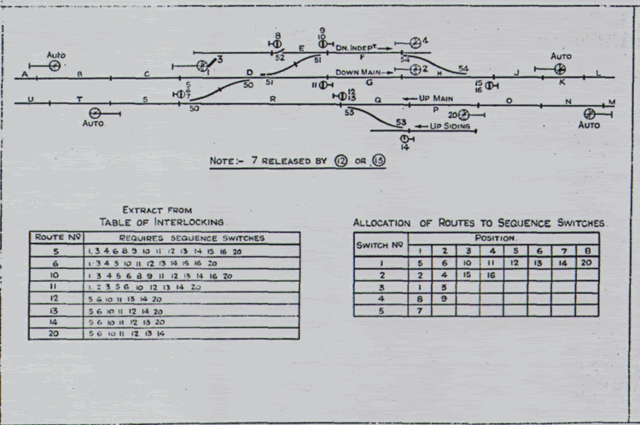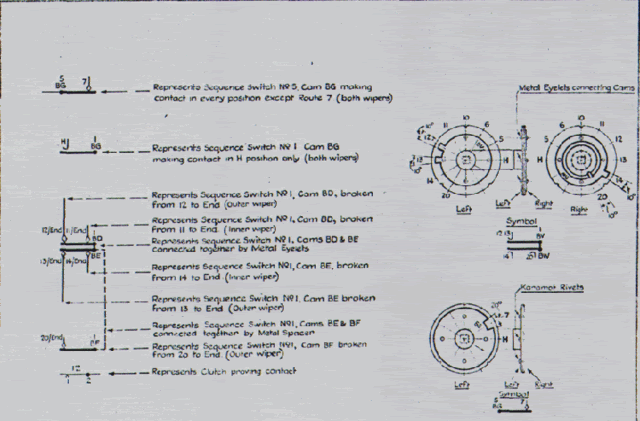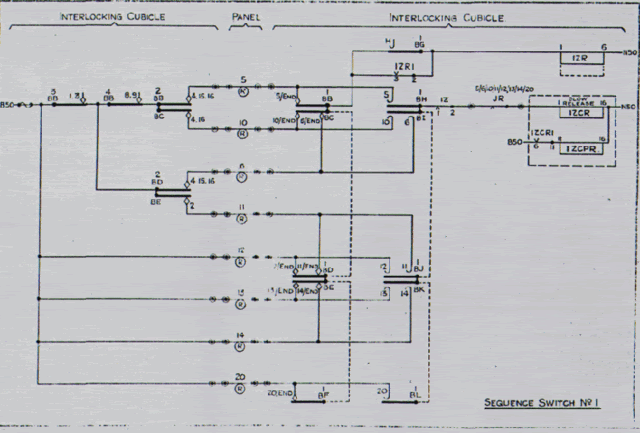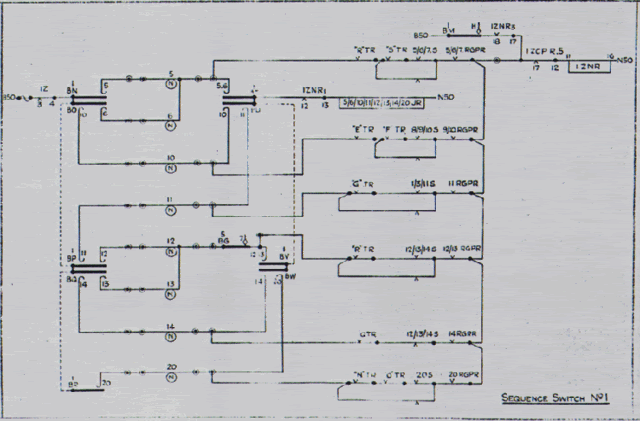This is going to be the first in a series of inside looks at METRA interlocking towers in the Chicago area. All of the behind the scenes photos that will be shown here were sent to me from an employee who had access to the towers in the time period 2006-2008 so don't go asking me how I was able to get into all these places. However some of the sets will be interspersed with exterior shots that I have taken of the tower and/or interlocking.
Gresham Junction Tower, on Metra's Rock Island District commuter lines operating south of Chicago is a surprising survivor where conventional wisdom would have dictated its closure well before its actual demise on Jan 30th, 2010. The tower is also of special interest to the British signaling community because of the
interlocking equipment installed within. For those of you who don't know, Gresham Junction housed unique Sequence Switch interlocking machine made by Standard Telephones and Cables Ltd of London. It was an NX design developed in the 1950's from Rotary system telephone exchange equipment. Not many were sold and Gresham Junction was the only unit installed in North America. The only other STC Sequence Switch interlockings anywhere in the world were two 1949 models installed in the old LNER boxes at Doncaster North and South and two improved models installed at Tollerton and Pilmoorin 1960 and 1961.
Gresham Junction is located at the northern split of the two Rock Island District sub-lines, which for lack of a proper name I will refer to as the Slow Line and the Fast Line. The Slow Line is used by most trains and has 11 stops between Gresham and Blue Island. The Fast Line is only used be a few rush hour express trains and has only two stops. Where the two lines re-join in the south there is the also still active Metra Blue Island tower, which has a more conventional NX board and is not to be confused with the more famous Blue Island tower nearby. As indicated by this line guide The Slow Line between Gresham Junction and Metra Blue Island is unsignaled, with trains operating under a Controlled Block system between the two interlockings. The Fast Line is signaled for bi-directional operation. In addition to the split Gresham Junction also handles a wye connection to an infrequently used connecting track that eventually winds up at the former US Steel plant in South Chicago near the famous Quad Draws at CP-509.
The tower is also unusual in that it is located such that a city street is between it and the Fast Line track it looks out on. In this photo we see the rear of the tower. The front can be covered by Google Street View. The tower has a typical slab side 50's design common to both towers in the Blue Island area.
Moving inside the tower we find a typical British green angled panel
with some rather outsized NX knobs.Each knob had a number of possible
route selections. All the operator had to do was turn the knob to the
desired route and press in. To cancel a route the knob would be popped
back out. While the interlocking is clearly oriented North/South, the
tracks of the old Rock Island carry an East/West designation in the
timetable, so operators have drawn a handy compass rose on the panel.
The line heading east used to sport 3 tracks, but the topmost one is now
just a stub. Yes, there is a bit of an odd bottleneck on both lines
where trains in both directions must squeeze through a single path. You
can see where another turnout used to be located between the eastward
slow line track and main track 2 and also that there were 3 tracks in
the west direction as well. The tower still supports a double slip
switch that all slow line traffic must negotiate. Finally note the
blocking tag on the entrance button to the Westward slow line, which is
probably in place for the manual block protection.
On the right side of the panel we see more of the same
including a second compass rose. The wye track used to have a
controlled switch at its east point, but that is now hand operated.
Pulling back to a wider angle we see the photo probably dates sometime
after 2006 given the date on the retirement plan announcement taped to
the panel. The company issued 2003 calender is quite a bit out of date.
In case of Nuclear War we can see that this tower is equipped with
ample supplies of water and paper towels. While the panel has seen a
typical number of "deletions" over the yeard, its interesting how much
room there was on the "west" side of the board. I am unsure if there
were plans to add more interlockings or signal the slow route, but I do
not believe anything was ever removed from that section of the panel.
Moving into the locking room we find the guts of the interlocking in
the form of sequence switches derived from telephone exchange
technology. Sequence switches were developed by Bell Labs at as part of the common control equipment used in both rotary panel switches, with panel being adopted for the North American market, with rotary being sold in Europe. An in depth explanation and demonstration of telecom sequence switches can be found courtesy of the Connections Museum in Seattle.
Here are selectors 1
through 5 and its astonishing how well maintained the equipment is. It
is a testament to the original manufacturer and its subsequent
maintainers that the equipment not only remains in service 50 years
later, but also that it continues to look brand new. What is all the
more astonishing is that the Rock Island railroad that built and owned the tower for its first 25 years was constantly going bankrupt.
Here we have selectors 7-11 and some better views of the glass encased
relays. I am wondering where Metra obtains spare parts for such an odd
duck. Due to the nature of the importation it is possible the Rock Island was
smart enough to lay in a large supply of spares from STC or perhaps
when electro-mechanical telephone switching was on its way out someone
at the Rock Island or Metra were able to lay in a supply from British Telecom.
Sequence switches employ an externally triggered clutch mechanism
that start the switch discs rotating, which in turn makes or breaks contacts in
a method similar to a Model 14 lever spindle. some of which might halt
the sequence switch to await further input. For example a route request would trigger a switch to rotate into a position requesting switch alignment, upon completion the switch would be triggered to rotate again possibly displaying the signal and locking other switches from rotating. At the time of its development this method advanced NX capabilities with substantial savings in relay and wiring costs as a spindle of rotating discs were far less costly than safety critical glass cased relays. Still, the technology never caught on possibly due to it being offered by an international telephone equipment company in no way affiliated the usual signaling OEMs.
For those of you who can understand such things here are some regrettably low res scans of some circuit and interlocking diagrams for a sample STC SSI interlocking designed for British operation.
Layout and Interlocking, typical circuits
Circuit conventions and typical cam cutting
Sequence Switch positioning circuit
Sequence Switch restoring circuit
Sequence Switch lock out circuit
Typical point control and indication circuit
I'll wrap things up with a shot of the builder's plate so you can have your Moment of British Pride.
Well that's all I have. It's a shame that this tower had to finally meet its end, but we should all be amazed that it lasted so far into the 21st century. Let's hope that all of this unique equipment made it into some form of preservation instead of a dumpster or the scrapyard.
A blog devoted to explaining the ins and outs of North American railroad signaling, past, present and future. This blog seeks to preserve through photo documentation the great diversity and technical ingenuity of 20th century signaling and interlocking hardware and technology. Related topics cover interlocking towers and railroad communications infrastructure.
Note, due to a web hosting failure some of the photos and links may be unavailable.
Search This Blog
Saturday, June 25, 2011
Subscribe to:
Post Comments (Atom)















"Slow line" = "Suburban Line" or "Dummy Line" as "Dummy" was Rock Island slang for the commuter trains to suburbia.
ReplyDelete"Fast Line" = "Main Line."
There was a nice article about Gresham in the August, 1953, issue of Railway Signaling and Communications.
Tom Wargin
extra board towerman at Gresham, 1960-1963
Might I respectfully ask for the source of the info that the panels at Tollerton and Pilmoor in the UK were also sequence switch interlockings? The two at Doncaster certainly were; I suspect that Tollerton and Pilmoor were conventional relay interlockings, although with control panels that strongly resembled Gresham and Doncaster. Many thanks and best wishes! Neil
ReplyDeleteProbably a reply when I posted this on the Signalbox.org forum. I don't know about those places to make it up XD
DeleteNo problem, that would explain it. To cross-check I even got a copy of the ST&C history (called Power of Speech A History of Standard Telephones & Cables 1883-1983) but that was 99% telephones so no help. Some old timers who remembered the Tollerton installation were pretty sure there had been no sequence switches. But, together with Pilmoor, it WAS ST&C. I will follow up a couple of leads at the National Rly Museum in York.
ReplyDeleteLet me know what you find and I'll update the post as necessary.
Delete